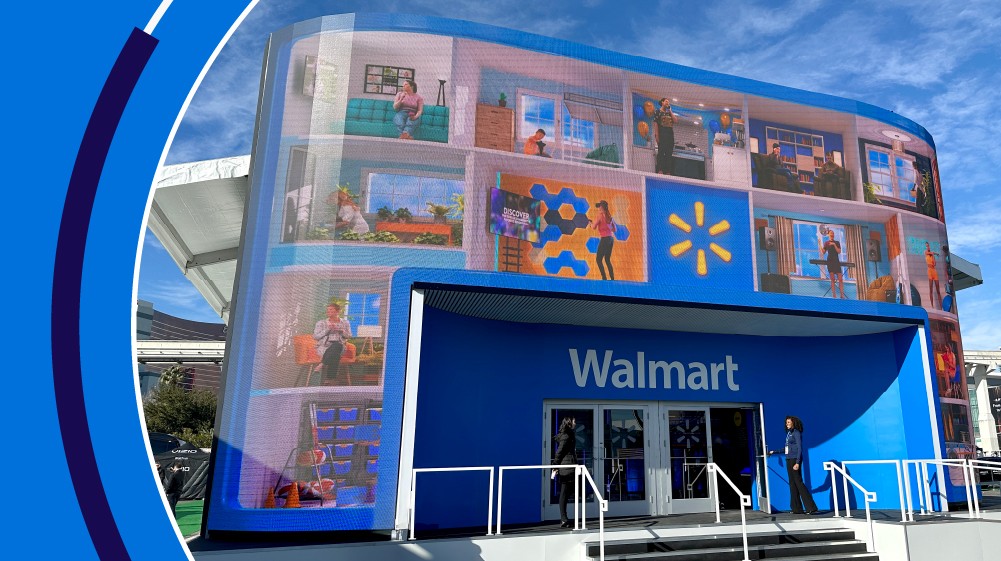Walmart’s tech bona fides were on full display at CES in Las Vegas, as Doug McMillon, the big box chain’s president and chief executive officer, hit the keynote stage on Tuesday to unveil new shopping tools spanning artificial intelligence, augmented reality and more.
A new AR social commerce initiative, “Shop with Friends,” builds on the retailer’s AI-based virtual fashion try-on tool and expands it into a whole platform. Users can create virtual outfits with pals, share the looks and solicit feedback. Think of it as an online version of playing dress-up with friends using digital versions of real clothes that are, of course, for sale at Walmart.
Shop with Friends is being tested as a beta, but when it graduates, it will effectively turn Walmart into a social media company.
Another announcement introduces a new generative AI-powered search tool, and it looks rather consequential, because it reimagines the product search experience on a conceptual level: Instead of typing out keywords, products or brand names, Walmart encourages customers to search for items by describing the context, according to McMillon.
“For example, let’s say you’re throwing a party for next month’s Super Bowl. Previously, you might run numerous searches for chips, wings, drinks and a new 90-inch television,” he said. “In the new experience, you search once, for something intuitive, and the app shows you everything you might need.”
The redesigned search function puts relevant product categories at the top and displays a list of curated results. It’s similar to Google’s generative searches, and with leaders in tech and retail both embracing AI-driven contextual search, it’s rather likely that consumers will expect that level of nuanced search everywhere.
Naturally, this type of tool hinges on the quality of its results. To ensure the experience is as sophisticated as possible, Walmart — an employer of more than 28,00 developers and other technical staff that usually likes to build its own tech — expanded the effort beyond the company.
McMillon explained that it collaborated with Microsoft, which has been a long-time technology partner, and it also used a range of large language models, including those from Azure and OpenAI, as well as its own retail- and Walmart-specific LLMs.
“It’s our models and our data that put the finishing touches on this improved experience,” he added. “Our new search fundamentally changes the way customers engage with us.” The feature is coming to the website and to the iOS app first, but will be available “across all platforms” this quarter.
That’s not the end of Walmart’s AI ambitions. It’s also launching a new service through its InHome program that can automatically replenish frequently purchased products and deliver them directly to refrigerators or other eligible spots. This is more intelligent than auto-delivery or subscriptions, as InHome Replenishment learns and adapts to customer needs over time.
The tech industry often talks about development as either a marathon or a sprint. At Walmart, it’s both. When it comes to innovation, the company is in it for the long haul, as it jumps into a plethora of new and emerging technologies at a rapid clip.
McMillon put it this way: “At Walmart, we’re very excited about how we’re putting technology to work to improve the lives of our customers and associates — and the years ahead [don’t] look like anything we’ve seen in our past, as it relates to the magnitude of technological change in our company.”
The past few years have taken the retail behemoth into livestream shopping, virtual branding and digital twinning, among many other areas, including other aspects of AI. Prior to CES, the retailer showed off an AI shopping assistant that can answer questions and advise or recommend products to customers while they browse. My Assistant, an internal AI tool that helps employees create documents and many among other things, will expand to more regions and languages. Sam’s Club plans to use AI and computer vision to banish receipt verification at exits.
Beyond AI, Walmart also announced an expansion of drone delivery to 1.8 million more households in the Dallas-Fort Worth region, with a reach of 75 percent of the area. The compact aircraft appears to be finally taking flight, with Amazon’s plan for a limited launch in late 2024. Just before the show, the company partnered with Unity, a leader in game engines and virtual world content, to bring its commerce APIs directly to their games and apps in an “immersive commerce” bid.
At first blush, Walmart’s spate of projects and features could look like a firehose wielded by a company that can’t make up its mind — or a mad dash to battle rival Amazon on its own tech turf in any way it can.
But this is no “spray and pray” approach. According to the CEO, Walmart does have a strategy and it’s called “adaptive retail.” McMillon and other executives describe it as an expansive, yet flexible vision of business that’s capable of seamlessly molding to the customer’s needs.
Personalized retail is not a new concept. Brands have been chasing this dream for years. But it’s only recently that technology has started getting good enough to put the dream within reach.



